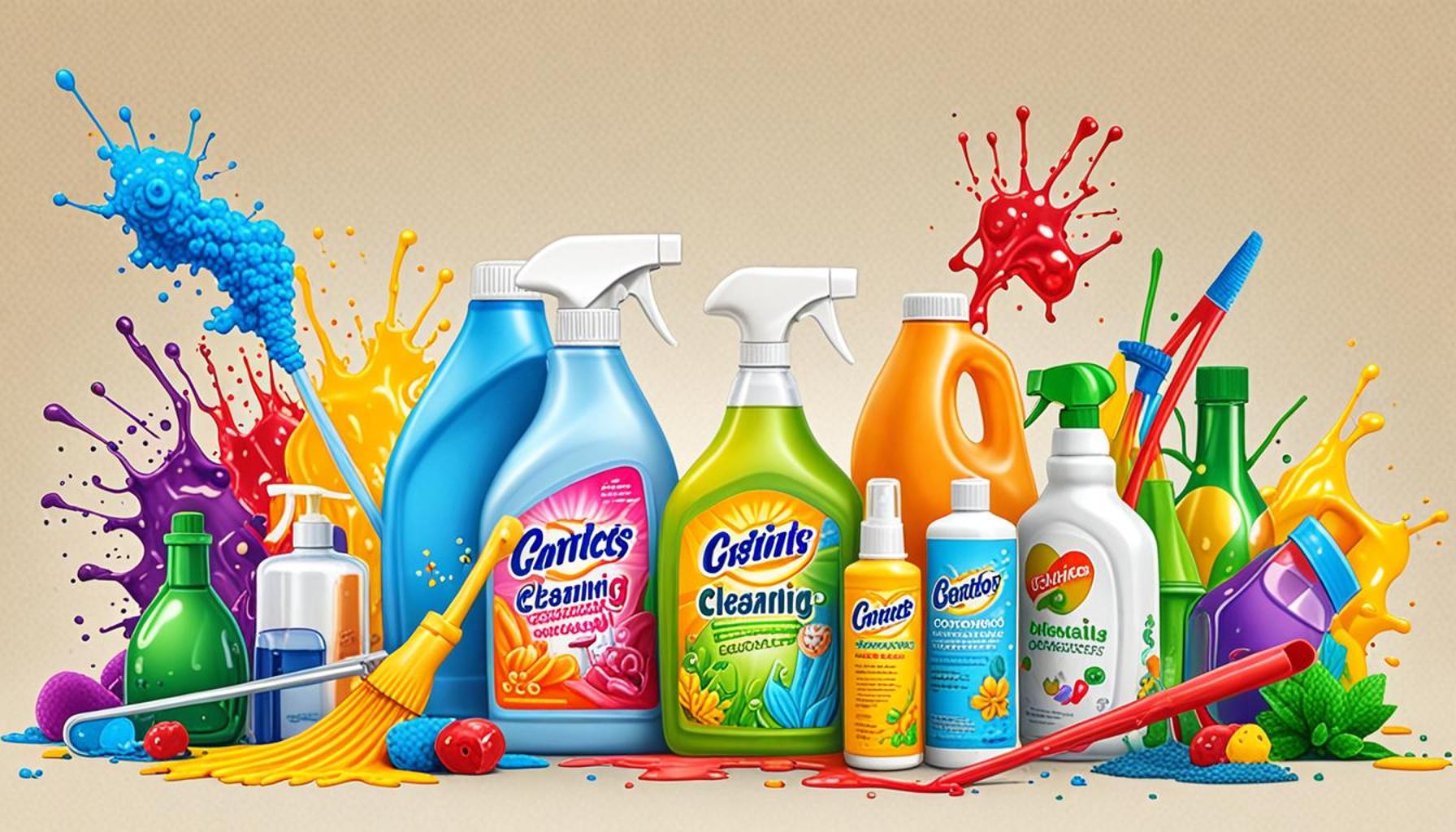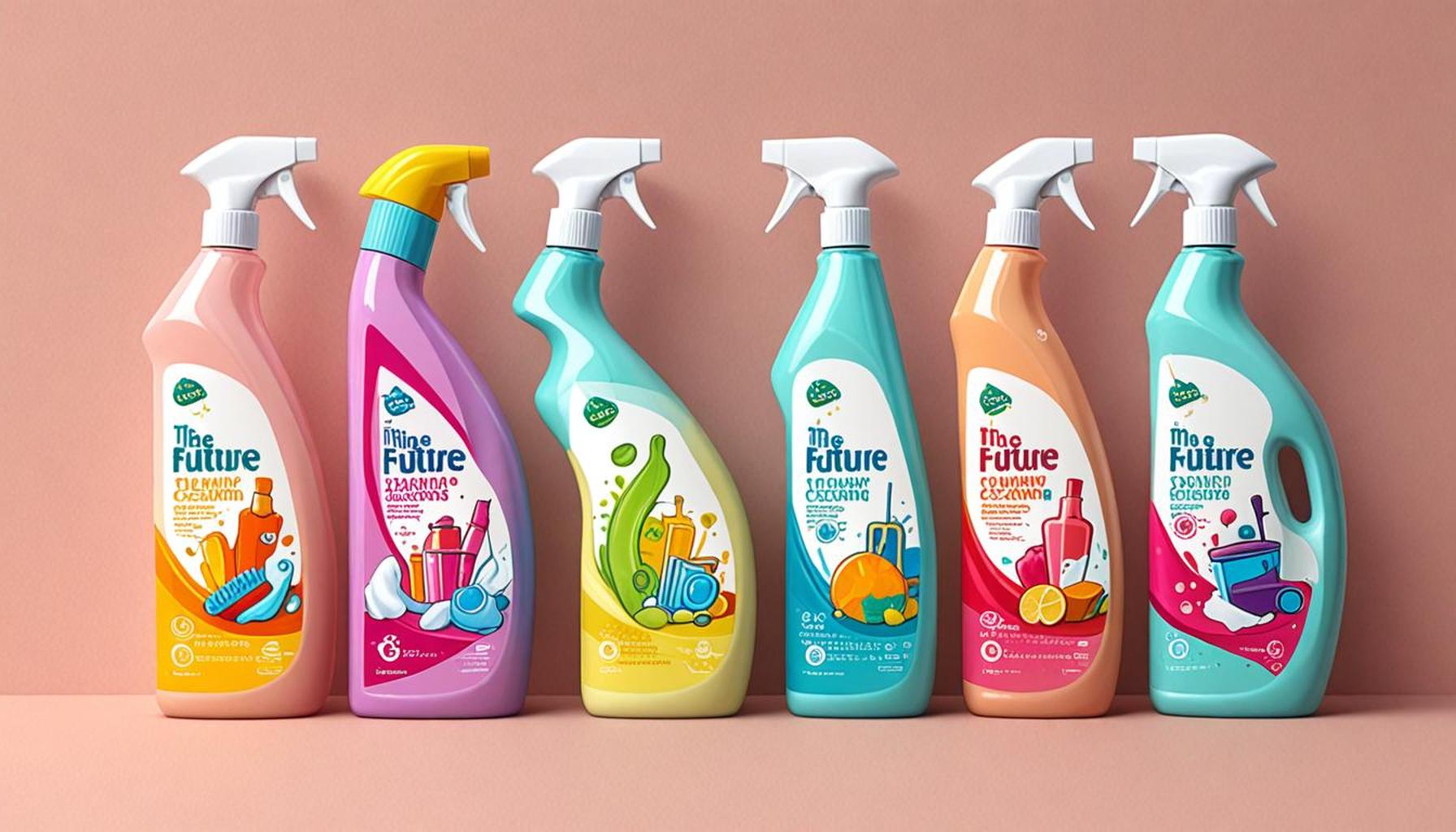The Rise of Eco-Friendly Cleaning Products: Benefits and Best Practices

The Rise of Eco-Friendly Cleaning Products
As society becomes increasingly aware of the environmental challenges we face, the popularity of eco-friendly cleaning products is on the rise. These alternatives to traditional cleaners not only promise to keep our homes spotless but also focus on protecting our planet. Many consumers are discovering that making green choices can lead to remarkable benefits for their health and the environment.
Healthier Homes
Healthier homes are one of the primary benefits associated with eco-friendly cleaning products. Unlike conventional cleaners, which may contain a plethora of harsh chemicals, organic or plant-based alternatives often incorporate natural ingredients such as vinegar, baking soda, and essential oils. For instance, brands like Seventh Generation and Method offer products made from biodegradable materials that are less likely to irritate the skin or trigger respiratory issues among residents. This is particularly important for families with young children or pets, who are more susceptible to the harmful effects of strong chemicals commonly found in traditional cleaners.
Reduced Environmental Impact
Choosing eco-friendly cleaners also leads to a reduced environmental impact. Many of these products are designed to be biodegradable, meaning they break down naturally and do not contribute to pollution in our ecosystems. For example, by selecting products that do not contain phosphates or chlorine, consumers can significantly influence the quality of their local waterways. A recent study found that over 1.4 billion pounds of toxic cleaning chemicals enter U.S. waterways each year. By making informed choices, consumers can help combat this issue.
Improved Indoor Air Quality
Traditional cleaning products often emit harmful volatile organic compounds (VOCs), which can adversely affect indoor air quality. In contrast, improved indoor air quality is commonly achieved through the use of eco-friendly cleaners. Products that are labeled as “low-VOC” or “no-VOC” contribute to a healthier living environment by reducing the number of toxins present in the air. This is crucial, particularly for individuals suffering from allergies, asthma, or other respiratory conditions.
In the United States, the market for green cleaning products has witnessed impressive growth, with studies indicating that over 50% of American households have made the switch to eco-friendly alternatives over the past year. This trend emphasizes a collective shift towards more conscious consumerism, reflecting an emerging awareness of the environmental implications of our choices.

Moreover, adopting eco-friendly cleaning practices involves understanding product labels, using products effectively, and even exploring DIY cleaning solutions. Many homemade cleaners, using ingredients like lemon juice or essential oils, can be just as effective as store-bought options. By educating oneself and making intentional choices, individuals can embrace a cleaner home while also contributing to a healthier planet.
For those interested in joining this green movement, researching brands, understanding the ingredients, and sharing knowledge with friends and family can serve as impactful steps towards a more sustainable lifestyle.
DIVE DEEPER: Click here to learn more
Advantages of Eco-Friendly Cleaning Products
The shift towards eco-friendly cleaning products is not merely a trend, but a significant evolution in consumer behavior driven by a deepening awareness of health, sustainability, and ethics. This transition brings with it a host of advantages that are reshaping the way we perceive cleanliness and hygiene in our homes.
Cost-Effectiveness
One of the often-overlooked benefits of using eco-friendly cleaning products is their cost-effectiveness. While some premium green brands may come with higher price tags, many eco-friendly solutions can be created right at home using common ingredients. Simple items like vinegar, baking soda, and lemon juice can be assembled into highly effective cleaning agents for a fraction of the cost of commercial products. For instance, a basic all-purpose cleaner can be made by mixing equal parts of vinegar and water, offering an economical alternative that outperforms traditional cleaners in various scenarios.
Enhanced Cleaning Power
Contrary to the misconception that eco-friendly products are less effective, many consumers have found that natural cleaning solutions can deliver a powerhouse of cleaning efficacy without the harmful side effects. Enhanced cleaning power can be achieved through thoughtful formulation with natural ingredients. Ingredients such as tea tree oil and citric acid not only provide strong antibacterial properties but also leave surfaces sparkling clean. Research suggests that many plant-based ingredients possess inherent antibacterial and antifungal qualities that rival their synthetic counterparts.
Support for Sustainable Practices
Using eco-friendly cleaning products also fosters a commitment to broader sustainability practices. Many manufacturers of green cleaning solutions are dedicated to ethical sourcing, reduced packaging, and carbon footprint minimization. By supporting these brands, consumers actively promote a shift towards sustainable manufacturing practices. Here are some aspects to consider when seeking sustainable products:
- Brand Transparency: Opt for companies that openly share their sourcing and production methods.
- Biodegradable Packaging: Favor products packaged in recyclable or compostable materials.
- Certifications: Look for labels that indicate third-party certifications such as ‘USDA Organic’ or ‘Green Seal’ to validate claims of sustainability.
This growing recognition and demand for sustainability alongside effective cleaning solutions have spurred innovation in the industry. Many brands are now vigorously investing in research and development, seeking to create products that meet the high standards of modern consumers.
As consumers navigate the vast array of options, understanding the most effective ways to incorporate these eco-friendly solutions into their daily routines will further empower them to embrace cleaner homes and a healthier planet. As more individuals become advocates for eco-friendly cleaning practices, the potential for significant environmental change grows exponentially.
The Rise of Eco-Friendly Cleaning Products: Benefits and Best Practices
The growing awareness surrounding environmental issues has compelled households and businesses alike to shift towards eco-friendly cleaning products. This change is not just a trend; it embodies a commitment to sustainability and health. By adopting green cleaning solutions, users can significantly reduce their carbon footprint while promoting a healthier indoor environment.
One major benefit of eco-friendly cleaning products is their formulation. Most green cleaners are derived from natural ingredients, minimizing the risk of exposure to harsh chemicals that are prevalent in conventional cleaning products. This is particularly important for vulnerability among children, pets, and individuals with allergies or respiratory conditions. Not only do eco-friendly cleaners prioritize human health, but they also protect our ecosystems from toxic run-off and pollution.
Furthermore, these products often show remarkable effectiveness. Contrary to misconceptions, many eco-friendly options can match or even surpass traditional cleaners in performance. Through innovative technology, manufacturers are harnessing natural ingredients that effectively break down dirt and grime while still aligning with social responsibilities. Therefore, choosing environmentally conscious alternatives can lead to a cleaner home and a cleaner planet.
To enhance your understanding of eco-friendly cleaning products, referring to best practices in their usage can maximize their benefits. For instance, it’s essential to follow product instructions carefully — dilution levels, application methods, and storage recommendations can significantly influence effectiveness. Additionally, exploring DIY cleaning solutions offers an engaging way to ensure that cleaning routines are both environmentally friendly and cost-effective, allowing you to tailor mixtures based on specific cleaning needs.
| Category | Key Features |
|---|---|
| Sustainability | Utilizes natural ingredients and biodegradable formulas |
| Health Benefits | Reduces exposure to harmful chemicals, safer for families and pets |
As the demand for eco-friendly cleaning products continues to rise, consumers are presented with more options than ever. Exploring new alternatives not only helps in finding effective solutions for cleanliness but also complements efforts towards creating a sustainable environment. Embrace the change and lead your cleaning habits towards greener practices.
DISCOVER MORE: Click here to learn about minimalism’s benefits for cleaning efficiency and sustainability</
Best Practices for Implementing Eco-Friendly Cleaning Solutions
As the popularity of eco-friendly cleaning products continues to rise, understanding how to align daily cleaning routines with sustainable practices becomes essential. The transition towards greener living not only reflects an individual’s commitment to the environment but also fosters a healthier home. Below are several best practices that can enhance the effectiveness of eco-friendly cleaning efforts.
Understanding Ingredients
One of the most significant best practices in adopting eco-friendly cleaning products is understanding the ingredients used in these solutions. Consumers should educate themselves about common natural ingredients and their respective cleaning properties. For example, baking soda acts as a natural scrubber, removing stains and odors, while essential oils such as eucalyptus or lavender not only provide pleasant fragrances but also carry antibacterial properties. Being informed allows consumers to select products that align best with their cleaning needs, streamlining their choices for effective cleaning.
Creating a Green Cleaning Kit
Building a green cleaning kit at home can be both practical and cost-effective. Essential items to include in this kit are:
- All-Purpose Cleaner: A simple mix of vinegar and water can tackle various surfaces.
- Microfiber Cloths: These are great for capturing dust and dirt without the need for chemical agents.
- Casting Soap: A versatile soap derived from natural fats and oils; useful for washing dishes and surfaces.
- Homemade Air Fresheners: Combine water with essential oils for a natural scent without synthetic fragrances.
Having these items readily available simplifies the cleaning process and encourages more frequent use of eco-friendly solutions.
Eco-Conscious Usage and Disposal
Alongside product selection, eco-conscious usage and disposal of cleaning products are paramount to maintaining sustainability practices. Here are a few tips to consider:
- Use the Right Amount: Avoid overusing products—following the manufacturer’s instructions on product usage can significantly reduce waste.
- Consider Concentrates: Purchasing concentrated versions of cleaning solutions can minimize packaging waste and save money.
- Proper Disposal: Check municipal regulations regarding the disposal of cleaning products. Many eco-friendly brands offer refill stations or recycling initiatives.
Actively engaging in these practices not only enhances the efficacy of cleaning products but also promotes a thoughtful approach to home maintenance that avoids unnecessary waste.
Building a Green Routine
To create long-lasting habits, integrate eco-friendly cleaning into your weekly routine. For instance, designate specific days each week for different cleaning tasks, utilizing natural products consistently. This practice not only helps maintain cleanliness but gradually reinforces the environmental benefits of sustainability to all household members. Sharing knowledge and experiences about green cleaning within the home can encourage everyone to participate, fostering a communal commitment to a healthier living environment.
As the landscape of cleaning products evolves, the integration of eco-friendly alternatives is increasingly recognized not only for their household benefits but also for their positive impact on the planet. By adopting informed practices and methods, consumers can enhance their eco-centric lifestyles, contributing to a collective movement towards sustainable living and cleaner communities.
DISCOVER MORE: Click here to learn about sustainable decluttering strategies</
Conclusion
The rise of eco-friendly cleaning products represents a significant shift towards more sustainable living, underscoring the growing awareness of environmental issues and the desire for healthier home environments. As consumers increasingly recognize the detrimental effects of traditional cleaning agents, the demand for natural alternatives is soaring. This transformation not only benefits individual households by reducing exposure to harmful chemicals but also plays a crucial role in preserving our planet.
Embracing practices such as understanding ingredients, creating a well-equipped green cleaning kit, and promoting eco-conscious usage and disposal will empower households to clean responsibly. With the plethora of natural options available, consumers can take control of their cleaning routines, ensuring that effectiveness does not compromise their commitment to sustainability. Furthermore, fostering a green routine within the home can turn cleaning into a shared, engaging experience rather than a chore, encouraging collective efforts towards a healthier lifestyle.
As we move forward, it’s essential to remain vigilant and informed. Exploring eco-friendly options not only presents an opportunity to improve daily life but also aligns with a broader movement towards environmental stewardship. The benefits of eco-friendly cleaning products extend beyond the immediate environment of our homes, contributing to the larger goal of a cleaner, greener future for all. By continuing to educate ourselves and actively support sustainable practices, we can collectively ensure that this rise in eco-friendliness remains a powerful driver of positive change.


